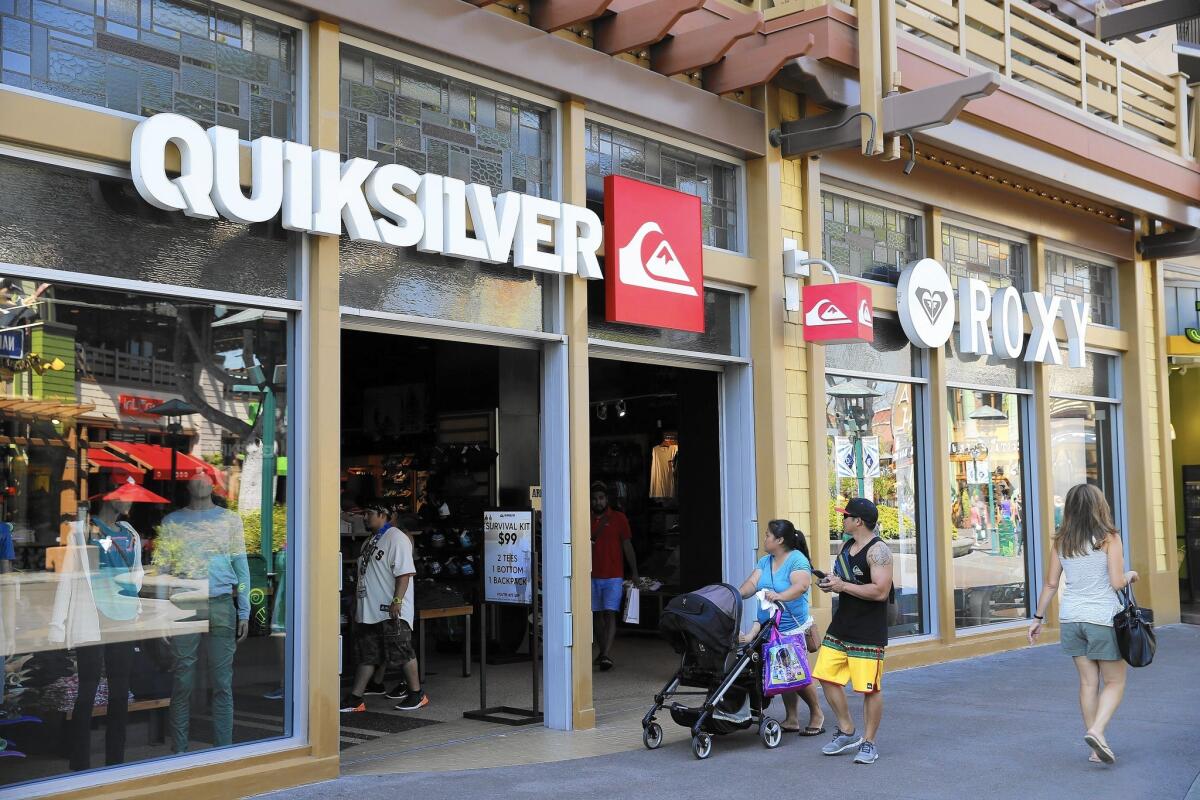Quiksilver files for bankruptcy in U.S.; local stores on closure list

Quiksilver, the iconic Orange County surfwear company, rode America’s fascination with the surfer lifestyle to become a retail powerhouse.
In 1986, it was the first surfwear company to go public and over the decades benefited as young shoppers across the country sought to emulate what they saw as the cool lifestyle of surfers, skateboarders and snowboarders.
But the declining popularity of such gear, coupled with competition from other fashion brands and strategic missteps, caused the Huntington Beach-based mainstay to wipe out in recent years, prompting the company on Wednesday to file for Chapter 11 bankruptcy protection for its U.S. businesses.
“There is just fewer kids out there that think the surf market is cool,” said analyst Mitch Kummetz of B. Riley & Co. “The heyday of the late ‘90s and the early 2000s is a distant memory.”
Timmy Phan, 35, of Irvine was one of the few shoppers Wednesday in Quiksilver’s store at South Coast Plaza in Costa Mesa.
He worked for a Quiksilver retail store as a teenager. He has been involved with urban streetwear since then and was upset about the company’s bankruptcy.
“Back then, Quiksilver was on top of their game, and I still think they’re the No. 1 surf brand in the industry,” he said. “It just [stinks] to hear. It’s a business thing.”
The company said Wednesday that it will close stores as part of its bid to “rationalize” its presence in the Americas. The South Coast Plaza location is among those listed for closure, as are stores at Fashion Island in Newport Beach, the Irvine Spectrum Center and Universal CityWalk, according to court documents. At the end of October, the company had 122 retail and factory outlet stores in the United States.
But the company still sees a future for its core Quiksilver, Roxy women’s wear and DC shoe brands and plans to continue in business. It filed a detailed restructuring plan that calls for debt holder Oaktree Capital Management, a Los Angeles firm that specializes in investing in troubled companies, to become majority owner after Quiksilver exits bankruptcy.
Chief Executive Pierre Agnes said the bankruptcy plan is a “difficult but necessary step” that will help complete a turnaround of the company’s U.S. business. The firm’s Asia-Pacific and European business units are not part of the bankruptcy filing.
In a statement, Agnes said the bankruptcy and the financing from Oaktree allow the company to “satisfy our ongoing obligations to customers, vendors and employees” and to “re-establish Quiksilver as the leader in the action sports industry.”
Since 2013, the company has been engaged in a turnaround plan that included store closures in the United States and a refocus on its three core brands. Last year, Quiksilver sold its licensed apparel subsidiary Hawk Designs Inc. for $19 million.
The Quiksilver brand got its start in Australia in 1969, when it was founded by surfer Alan Green. In 1976, champion surfer Jeff Hakman and Robert B. McKnight Jr. co-founded Quiksilver USA, and in 2002, the American businesses purchased the original outfit.
But Quiksilver was hurt by the recession and a move toward fashion retailers such as H&M and Forever 21 that appealed to price-conscious teenagers, analysts said. Last fiscal year, Quiksilver sales fell more than 10% and losses exceeded $300 million. By the time it filed for bankruptcy protection it had racked up debts of $826 million and assets of $337 million, according to court documents. The share price had fallen 80% since January.
Part of the problem, according to Craig Johnson, president of Customer Growth Partners, was that surf apparel companies continued to expand, even though many teens became less interested in donning clothing with labels such as Quiksilver, Volcom and Billabong. In Quiksilver’s case, the company opened too many stores, many in expensive areas such as Times Square in New York, he said.
The company took another hit last year when 11-time world surfing champion Kelly Slater ended his long-running sponsorship deal with Quiksilver to start his own brand. By that time, some surfers had come to view the clothing giant as too corporate in a sport that tries to maintain, and often markets, a counterculture vibe.
Marshal Cohen, chief industry analyst of The NPD Group Inc., said Quiksilver simply fell out of fashion with many non-surfing youths and was hurt by its reliance on a demographic that tends to treat brands as a “revolving door.”
“They are the most fickle,” he said.
But other surfwear brands are doing much better than Quiksilver, and corporate missteps compounded problems for the firm, Kummetz said.
In 2005, Quiksilver bought winter-sports company Rossignol, but the new unit quickly became a financial drag. Three years later, Quiksilver unloaded Rossignol for less than half the original purchase price of $320 million.
Former Chief Executive Andy Mooney also alienated retailers, partly by discounting goods online, Kummetz said. In March, current CEO Agnes replaced Mooney.
In a letter to U.S. employees, Agnes and Chief Financial Officer Greg Healy said the failed Rossignol acquisition cost the company close to $1.3 billion and “left us with a huge amount of debt.” With that deal, coupled with “poor management decisions that yielded a failed strategy and poor operational execution,” the company’s trajectory became “unsustainable,” the executives said.
As part of the bankruptcy plan, which must be approved in court, Quiksilver would receive about $175 million in new debtor-in-possession financing from affiliates of Oaktree Capital Management and Bank of America. As part of the reorganization, Oaktree, which owns 73% of the company’s senior debt, will convert its debt to equity, taking a majority ownership stake.
Cohen said Quiksilver might not retain the broad-based appeal it once held, but he believes it has a future.
“The brand has too much heritage, too much familiarity,” he said.
Khouri writes for the Los Angeles Times. Times Community News staff writer Anthony Clark Carpio contributed to this report.